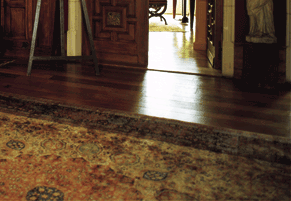 |
 |
|
by Kathleen A. S. Hay
|
Be it a Nantucket cottage filled with nautical antiques or an elegant Manhattan townhouse appointed with Louis XV furniture, decorating a house can be a daunting task. While it is exciting to imagine the possibilities, the practical aspects of realizing your dreams can sometimes be overwhelming. By following some simple guidelines, however, the process can be as enjoyable as the end results are gratifying.
|
 |
 |
Stair hall decorated with Russian religious iconography from the seventeenth to nineteenth centuries, and a seventeenth-century English Jacobean settle. This décor successfully combines objects from different time periods and countries.
|
 |
|
A successful decorating scheme is one that ensures you are surrounded with objects, colors, and textures that you want to live with. While this may seem obvious, many novice decorators fall into the trap of following the latest decorating trends, with disappointing results. No sooner has the powder room been painted a flamingo pink or the bedroom hung with blue-and-white chintz curtains, then the look has become dated. Making discerning choices based on classic design aesthetics will guarantee a successful decorating scheme and years of enjoyment.
|
 |
 |
Contemporary interior with an eclectic mix of French antiques and modern upholstered furniture.
|
 |
|
 |
 |
|
 |
 |
 |
French corner cupboard, circa 1800, filled with English, French, and Flemish silver from the eighteenth and nineteenth centuries, illustrating the successful grouping of related objects to create a strong visual accent.
|
The ability to pull together the elements in a room so that it is aesthetically pleasing is not something you have to be born with. You can educate your eye and become familiar with the fine points of interior design by regularly looking through source books and magazines that specialize in home décor. Or hire a design professional who can help you make reliable choices and avoid costly errors. A designer can also find new and interesting ways to work with limited space, or help build a room around grandmother’s favorite highboy.
Antiques are a terrific way to personalize your space and lend uniqueness to a room. Searching for the perfect antique also adds an element of fun to the decorating process. Collectors always have stories to tell about particular finds, and a room punctuated with reminders of happy adventures will add a special dimension to your environment.
Learn as much as you can before you make a purchase by researching historic periods of design and by browsing antiques markets and dealer shops. Don’t feel intimidated about asking for help and insight. Dealers can be a tremendous resource, and most are happy to share their knowledge with the novice and enjoy making suggestions on appropriate pieces for specific interior spaces.
|
|
 |
|
A Russian religious screen, placed beneath a modern hand-painted over-mantel and marble fireplace, is used as the centerpiece for this mantel wall.
|
When buying antiques, whether large or small, purchase items of quality; you will always be rewarded for spending more on a better piece, even if it means purchasing less. A single antique, if it is an item of quality, can ground a room, adding importance and greater appeal to the space.
The correct antique can offer a focal point around which to decorate, or it can provide an accent that complements the space as a whole. For instance, a single decorative object, such as a piece of statuary in a well-lit niche, offers a strong design statement. Alternatively, an object grouped with related items increases impact for a broader aesthetic appeal.
Consider using old items in new ways. An old coal scuttle can become storage for newspapers and magazines. Garden statuary can be more interesting, and certainly more unexpected, when used indoors. A reclaimed architectural remnant such as an eighteenth-century marble butcher’s counter can be the starting point for a renovated kitchen, lending an air of uniqueness to an otherwise ordinary room. By creating an eclectic environment you will make your space more inviting. Mix modern furniture with antiques or combine different stylistic periods with abandon.
 |
|
|
Nineteenth-century carpentry tools are used to decorate a workshop wall.
|
The most important point to remember when decorating with antiques is to buy things you love, one object at a time, finding the perfect spot for them in your home. Rather than following fashion trends, follow your instincts. If a piece is still in favor hundreds of years after it was first made and used, odds are it will continue to be so in the future. It’s up to you to decide what to collect and how to introduce it into your personal space so that you have a warm, inviting home. But beware, decorating with antiques can become a serious addiction.
Kathleen A. S. Hay has been in the antiques and design business for the past twenty years, managing a well-respected firm on Nantucket Island, Massachusetts. Recently she started her own interior design business to augment her love of creating interior landscapes with antiques.
|
All photography by C. Davis Hall.
|
|
Suggested Books:
|
Clifton-Mogg, Caroline. Decorating with Antiques. New York: Little, Brown and Co., 1999.
Clodagh. Total Design. New York: ClarksonPotter, 2001.
Miller, Judith. The Style Sourcebook. New York: Steward, Tabori and Chang, 1998.
Pasanella, Marco. Living in Style Without Losing Your Mind. New York: Simon & Schuster, 2000.
|
|
Suggested Magazines:
|
The World of Interiors, British House & Garden, Veranda, and Architectural Digest
|
|
|
|
Antiques and Fine Art is the leading site for antique collectors, designers, and enthusiasts of art and antiques. Featuring outstanding inventory for sale from top antiques & art dealers, educational articles on fine and decorative arts, and a calendar listing upcoming antiques shows and fairs.
|